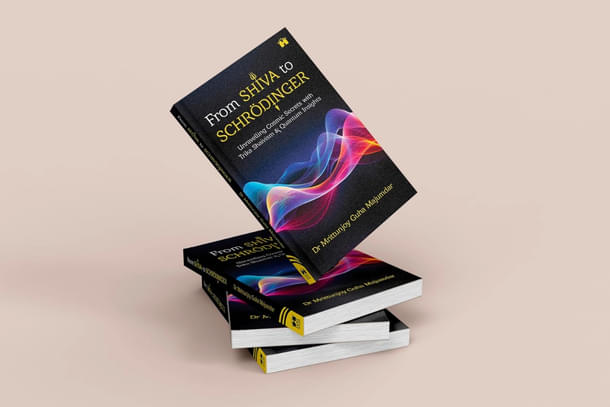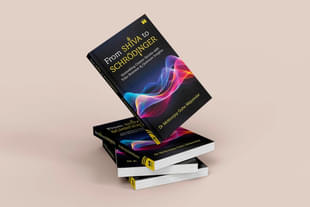Books
From Shiva to Schrödinger: A Cosmic Convergence Of Mysticism And Physics
Richa Gautam
Dec 30, 2024, 06:25 PM | Updated 06:39 PM IST
Save & read from anywhere!
Bookmark stories for easy access on any device or the Swarajya app.


From Shiva to Schrödinger. Dr Mrittunjoy Guha-Majumdar. Hay House Publishers India. Pages 240. Rs 400.
When a scientist, trained at the hallowed halls of Cambridge and Harvard, steps away from a thriving academic career to explore the philosophical and scientific roots of his own civilisation, the journey transcends personal ambition — it becomes a profound quest to reconnect the wisdom of the ancient with the frontiers of the modern.
From Shiva to Schrödinger, Dr Mrittunjoy Guha-Majumdar’s extraordinary work, is the culmination of this quest: a bold attempt to spark an intellectual renaissance that links Kashmir’s Shaivism with contemporary breakthroughs.
A protégé of Nobel Laureate physicist Brian Josephson, director of the Mind-Matter Unification Project, Dr Guha-Majumdar has carved his own place in the world of quantum physics. His ongoing contributions to quantum entanglement at the prestigious Cavendish Laboratory and his role as a presenter at the Linden Nobel Laureate Conclave highlight a career steeped in scientific rigour and innovation.
Yet, it’s his unique ability to weave together advanced ideas like Quantum entanglement and superposition with the metaphysical framework of Trika Shaivism, that bridges two seemingly disparate worlds for the reader. By connecting the dots between one of India’s most sophisticated philosophical systems and the cutting-edge revelations of quantum mechanics, Dr Guha-Majumdar’s work invites us to reimagine the universe as a harmonious interplay of science and spirit — where Shiva meets Schrödinger.
Beyond the ‘Tao of Physics’
While the intersection of Eastern philosophy and modern physics is not a new topic — Fritjof Capra’s The Tao of Physics was a trailblazer in the 1970s — Guha-Majumdar’s work stands apart due to its specificity and contemporariness.
Where Capra draws from a wide spectrum of Eastern traditions, including Hinduism, Buddhism, Taoism, and Zen, From Shiva to Schrödinger spotlights Trika Shaivism. Where Capra frames the science vs spirituality debate within an Occidental lens, Guha-Majumdar reclaims the dialogue with a definitive Bharatiya lens – an Indic worldview.
In doing so, From Shiva to Schrödinger emerges not only as a worthy successor to Capra’s seminal work but also as a bold expansion of the genre. It holds the potential to influence emerging fields such as consciousness studies, mind-matter theory, psychology, and even the life sciences, sparking a renewed understanding of the seamless continuum between physics and metaphysics.
About Trika Shaivism
The term coined by Guha-Majumdar to describe the quantum principles embedded within Trika Shaivism is ‘Quantrika.’ This concept within Trika Shaivism predates several pivotal moments in history.
To traverse timelines — the Darshanik foundations and spiritual insights of Shaivite Kashmir emerged nearly 400 years before the Islamic invasions, 500 years before Copernicus introduced heliocentrism, and 700 years before Newton laid the groundwork for classical physics. Most strikingly, Trika precedes Max Planck’s formulation of the quantum of energy by over a millennium.
Contextual and epistemological differences between Quantrika and quantum physics are undeniable, and Guha-Majumdar does not ignore them. Critics may contrast between the sutras, aphorisms of Trika Shaivism and the precise mathematical formalisms of quantum theory, but they will agree that the visionary sages of Kashmir explored a cosmic vision that resonates deeply with New Physics — revealing a sophisticated intellectual foresight far ahead of its time.
Just as Newton’s Classical Physics gave way to the more advanced theories of Quantum Physics, Trika Shaivism offers a deeper, more evolved perspective compared to Advaita Vedanta and Sankhya.
In a deep-dive, Guha-Majumdar meticulously explores core Trika principles, such as Abheda (non-duality), Spanda (cosmic vibration), and Pratyabhijna (self-recognition), and shows how they align with the most profound discoveries in quantum mechanics, such as superposition, entanglement, and the observer effect.
Parallels Between Physics and Philosophy
At the core of the book lies a fascinating question: how can ancient wisdom traditions, developed long before the advent of modern science, so accurately prefigure the discoveries of quantum mechanics? Guha-Majumdar answers this question by illustrating the shared themes:
Non-Difference (Abheda) and Entanglement
Trika Shaivism teaches that all existence is one, and the differences between subject and object are illusions caused by ignorance. Quantum entanglement, described as Einstein's "spooky action at a distance," shows that particles remain connected (in their properties) even when far apart, challenging our usual ideas of separateness and suggesting a deeper, unity in reality.
Similarly, in the chapter “The Nature of Reality” Guha-Majumdar, showcases David Bohm’s Bohmian mechanics — the deterministic pilot-wave theory of “interconnected web of entangled particles” aligning with Trika’s underlying oneness of Śiva-Śakti (non-dualism).
Non-Commutativity and the Game of Probabilities
Trika Shaivism explains how the interplay of Śiva and Śakti creates a structured, evolving reality where every moment holds significance. Similarly, quantum mechanics shows that outcomes depend on the sequence of events, reflecting a contextual and interconnected nature rather than an absolute one (non-absolutism).
The Observer Effect and Pratyabhijna
Both in quantum physics and Trika Shaivism, reality is not static but co-created through the dynamic interaction of the observer and the observed. In quantum physics, observation influences outcomes, highlighting the observer’s role. Similarly, Trika Shaivism teaches that individual consciousness (Nara) is inherently unified with universal consciousness (Śiva), and through self-recognition (Pratyabhijna), this unity shapes the perception of reality (non-reductionism).
While bridging the old and the new, Guha-Majumdar also offers a rigorous comparison of India’s diverse Shaivite traditions. Further, he distils complex concepts, intercepting the worldview of Trika Shaivism and juxtaposing it with the realities revealed by New Physics.
A Dharmic Meta-narrative for Kashmir
One of the book’s most striking aspects is how it draws readers into the intellectual and spiritual legacy of Kashmir.
Far from the strife-torn political landscape of the past few decades, Guha-Majumdar paints a vivid picture of Kashmir as one of the major cradles of Indic wisdom. He introduces us to the thinkers and saints who shaped Trika Shaivism — Vasugupta, the author of the Shiva Sutras; Somananda, the founder of the Pratyabhijna school; Utpaladeva who gave us the famous Iśvara-pratyabhijñā-kārikā - and the loveable Lalleshwari (Lal Ded), the mystic poetess whose Vakhs or verses encapsulate the essence of non-duality — simplifying the hermetic into the hummable — inspiring Kashmir, India and the world.
Guha-Majumdar transports readers to Kashmir as it once was; the land of Kashyapa, the sage after whom it is named, and of Shardapeeth, the seat of learning where scholars and saints delved into the mysteries of existence. He brings to life the philosophical debates, poetic expressions, and meditative practices that flourished along the banks of the Mahasarit (now Dal Lake).
This historical and cultural context enriches the book, making it not just a philosophical treatise but also a tribute to a region whose contributions to Indic thought are unparalleled.
Timeless and Timely: A Modern Relevance
The book’s strength is not just in its timelessness, but also in its timeliness. In an era when the rediscovery of Indic Knowledge Systems (IKS) is gaining momentum, From Shiva to Schrödinger serves as a vital contribution.
Guha-Majumdar’s exploration of Trika Shaivism is not just academic; it is deeply practical. By aligning its insights with contemporary science, he makes a compelling case for why this ancient Indian tradition deserves a place in global intellectual discourse.
The Philosopher and the Physicist
Physicists have long been drawn to philosophy. Think of Schrödinger’s reflections on Vedanta, Heisenberg’s fascination with the Upanishads, or Einstein’s musings on the cosmos. While Heisenberg wrote his seminal work Physics and Philosophy, Einstein aligned with the pantheism of Spinoza, declaring famously, ‘God does not play dice with the universe.”
In India, George Sudarshan, the visionary physicist brought Indian philosophical concepts into dialogue with modern physics, particularly through his work on quantum optics and tachyon theory.
Guha-Majumdar joins this tradition, bringing the rigour of a scientist and the depth of a seeker. His training in quantum mechanics and affinity for Trika Shaivism make for a compelling read for both scientific and spiritual audiences.
Beyond the Binary
A vital feature of the book is its exploration of realities beyond dualities: wave and particle, creation and destruction, good and evil. Guha-Majumdar shows us that these are not opposites but complementary aspects of a unified reality. Just as quantum physics reveals the fundamental particle-wave duality, Trika Shaivism teaches us to transcend the illusion of separateness and recognise the oneness underlying all existence.
Quantrika highlights this fusion, blending the emergent principles of quantum science with the holistic approach of Trika Shaivism. Themes such as self-organisation in condensed matter physics resonate with Trika's Pratyabhijna philosophy, where even opposites, as noted by Abhinavagupta, are part of a unified whole.
Conclusion: A Cosmic Convergence
From Shiva to Schrödinger is more than a book; it’s a journey across laboratories of quantum physicists to the meditative practices of Kashmir’s Shaivite sages.
Guha-Majumdar’s work is a testament to the enduring relevance of India’s philosophical heritage and its glorious contributions that undoubtedly illuminated contemporary scientific inquiries. Whether you are a physicist exploring metaphysical questions, a seeker delving into spirituality, or simply a curious reader, this book is an invaluable companion in your quest for knowledge.
Why You Should Read This Book
From Shiva to Schrödinger is an essential read:
For students of science seeking a philosophical foundation that enhances their understanding and practice of science without limiting their worldview.
For students of arts or humanities eager to explore science in a way that harmonises with profound philosophical and spiritual perspectives.
For curriculum developers looking to create a comprehensive and updated resource on the Indian Knowledge System.
For science educators aiming to inspire their students by connecting the richness of Indian traditions to the pursuit of scientific excellence.
For anyone fascinated by the mysteries of space, time, and consciousness, and the timeless dialogue between science and spirituality.
Richa Gautam is Executive Director at CaresGlobal, Founder of advocacy think tank, CasteFiles and has several years of experience as a Researcher and data analyst in the corporate world. Her education in theoretical physics and her personal fascination with the Shiva Sutras, was useful in writing this book review. Valuable inputs from Aravindan Neelakandan, have enriched this review immeasurably.





